A Simplified Design Method for Quasi-Resonant Inverter Used in Induction Hob
Abstract
:1. Introduction
2. Circuit Description
2.1. Circuit Operating Modes—Waveform Equations
2.2. Safe Operating Area for Quasi-Resonant Inverter
3. Proposed Design Method for Quasi-Resonant Inverter
- The DC source voltage ), the average input power , and the switch turn-on-time () and turn-off-time ( variables are defined.
- The maximum value of the coil current is calculated with the help of the relevant circuit equations.
- By detecting the first harmonic component of the voltage applied to the resonant circuit, the load resistance is calculated.
- After calculating the load resistance, the equivalent inductance value, is calculated with the help of the circuit equations.
- The of the series circuit are determined with the help of calculated variables.
- The resonant capacitor value is calculated with the help of resonant frequency and inductance value .
- The design is verified by calculating the coil current and capacitor voltage boundary conditions.
3.1. Defining of the Time Intervals and , the Source Voltage , and the Input Power
3.2. Calculation of the Maximum Coil Current
3.3. Calculation of Value by Determining the First Harmonic Component of the DC Voltage
3.4. Calculation of the Equivalent Inductance Value
3.4.1. LEQ Calculation Using Series Circuit Switch Current Value
3.4.2. LEQ Calculation Using Inductor Voltage Value
3.4.3. LEQ Calculation Using Inductor Energy Value
3.5. Determination the Series RLC Circuit Parameters
3.6. Calculation of the Resonant Circuit Capacitor Value Inductance Value
3.7. Calculation of Current and Voltage Boundary Conditions of Semiconductor Switch
3.8. The Flowchart of the Proposed Design Method
4. Verification of Proposed Analysis Method
4.1. Calculation Results
4.2. Simulation Results
4.3. Experimental Results
5. Conclusions
Funding
Data Availability Statement
Conflicts of Interest
References
- Komatsu, W.P.W. A simple and reliable class E inverter for induction heating applications. Int. J. Electron. 1998, 84, 157–165. [Google Scholar] [CrossRef]
- Omori, H.; Nakaoka, M. New single-ended resonant inverter circuit and system for induction-heating cooking apparatus. Int. J. Electron. 1989, 67, 277–296. [Google Scholar] [CrossRef]
- Tanaka, T. A new induction cooking range for heating any kind of metal vessels. IEEE Trans. Consum. Electron. 1989, 35, 635–641. [Google Scholar] [CrossRef]
- Lucía, O.; Maussion, P.; Dede, E.; Burdío, J.M. Induction heating technology and its applications: Past developments, current technology, and future challenges. IEEE Trans. Ind. Electron. 2014, 61, 2509–2520. [Google Scholar] [CrossRef]
- Lucia, O.; Navarro, D.; Guillen, P.; Sarnago, H.; Lucia, S. Deep Learning-Based Magnetic Coupling Detection for Advanced Induction Heating Appliances. IEEE Access 2019, 7, 181668–181677. [Google Scholar] [CrossRef]
- Has, U.; Wassilew, D. Temperature control for food in pots on cooking hobs. IEEE Trans. Ind. Electron. 1999, 46, 1030–1034. [Google Scholar] [CrossRef]
- Ekkaravarodome, C.; Charoenwiangnuea, P.; Jirasereeamornkul, K. The simple temperature control for induction cooker based on class-e resonant inverter. In Proceedings of the 2013 10th International Conference on Electrical Engineering/Electronics, Computer, Telecommunications and Information Technology, Krabi, Thailand, 15–17 May 2013; pp. 1–6. [Google Scholar]
- Kazimierczuk, M.K.; Wang, S. Frequency-domain analysis of series resonant converter for continuous conduction mode. IEEE Trans. Power Electron. 1992, 7, 270–279. [Google Scholar] [CrossRef]
- Lucia, O.; Sarnago, H.; Burdio, J.M. Soft-stop optimal trajectory control for improved operation of the series resonant multi-inverter. In Proceedings of the IECON 2014—40th Annual Conference of the IEEE Industrial Electronics Society, Dallas, TX, USA, 29 October 2014–1 November 2014; pp. 3283–3288. [Google Scholar] [CrossRef]
- Paesa, D.; Franco, C.; Llorente, S.; Lopez-Nicolas, G.; Sagues, C. Adaptive simmering control for domestic induction cookers. IEEE Trans. Ind. Appl. 2011, 47, 2257–2267. [Google Scholar] [CrossRef]
- Ozturk, M.; Zungor, F.; Emre, B.; Oz, B. Quasi Resonant Inverter Load Recognition Method. IEEE Access 2022, 10, 89376–89386. [Google Scholar] [CrossRef]
- Crisafulli, V.; Pastore, C.V. New control method to increase power regulation in a Ac/Ac quasi resonant converter for high efficiency induction cooker. In Proceedings of the 2012 3rd IEEE International Symposium on Power Electronics for Distributed Generation Systems, PEDG, Aalborg, Denmark, 25–28 June 2012; pp. 628–635. [Google Scholar]
- Sarnago, H.; Lucia, O.; Mediano, A.; Burdio, J.M. A Class-E Direct AC–AC Converter with Multicycle Modulation for Induction Heating Systems. IEEE Trans. Ind. Electron. 2014, 61, 2521–2530. [Google Scholar] [CrossRef]
- Sarnago, H.; Lucia, O.; Mediano, A.; Burdio, J.M. Direct AC–AC Resonant Boost Converter for Efficient Domestic Induction Heating Applications. IEEE Trans. Power Electron. 2014, 29, 1128–1139. [Google Scholar] [CrossRef]
- Vishnuram, P.; Ramachandiran, G. Capacitor-less induction heating system with self-resonant bifilar coil. Int. J. Circuit Theory Appl. 2020, 48, 1411–1425. [Google Scholar] [CrossRef]
- Park, H.P.; Kim, M.; Jung, J.H.; Kim, H.S. Load adaptive modulation method for all-metal induction heating application. In Proceedings of the 2018 IEEE Applied Power Electronics Conference and Exposition (APEC), San Antonio, TX, USA, 4–8 March 2018; pp. 3486–3490. [Google Scholar] [CrossRef]
- Sarnago, H.; Lucia, O.; Burdio, J.M. Multiple-output ZCS resonant inverter for multi-coil induction heating appliances. In Proceedings of the 2017 IEEE Applied Power Electronics Conference and Exposition (APEC), Tampa, FL, USA, 26–30 March 2017; pp. 2234–2238. [Google Scholar] [CrossRef]
- Lucia, O.; Carretero, C.; Palacios, D.; Valeau, D.; Burdío, J.M. Configurable snubber network for efficiency optimisation of resonant converters applied to multi-load induction heating. Electron. Lett. 2011, 47, 989–991. [Google Scholar] [CrossRef]
- Huang, M.S.; Liao, C.C.; Li, Z.F.; Shih, Z.R.; Hsueh, H.W. Quantitative Design and Implementation of an Induction Cooker for a Copper Pan. IEEE Access 2021, 9, 5105–5118. [Google Scholar] [CrossRef]
- Jeong, S.H.; Il Jin, J.; Park, H.P.; Jung, J.H. Enhanced load adaptive modulation of induction heating series resonant inverters to heat various-material vessels. J. Power Electron. 2022, 22, 1020–1032. [Google Scholar] [CrossRef]
- Han, W.; Chau, K.T.; Liu, W.; Tian, X.; Wang, H. A Dual-Resonant Topology-Reconfigurable Inverter for All-Metal Induction Heating. IEEE J. Emerg. Sel. Top. Power Electron. 2022, 10, 3818–3829. [Google Scholar] [CrossRef]
- Ramalingam, S.R.; Boopthi, C.S.; Ramasamy, S.; Ahsan, M.; Haider, J. Induction heating for variably sized ferrous and non-ferrous materials through load modulation. Energies 2021, 14, 8354. [Google Scholar] [CrossRef]
- Jin, J.; Kim, M.; Han, J.; Kang, K.; Jung, J.H. Input voltage selection method of half-bridge series resonant inverters for all-metal induction heating applications using high turn-numbered coils. J. Power Electron. 2020, 20, 1629–1637. [Google Scholar] [CrossRef]
- Jang, E.; Park, S.M.; Joo, D.; Ahn, H.M.; Lee, B.K. Analysis and Comparison of Topological Configurations for All-Metal Induction Cookers. J. Electr. Eng. Technol. 2019, 14, 2399–2408. [Google Scholar] [CrossRef]
- Sarnago, H.; Lucía, Ó.; Mediano, A.; Burdío, J.M. Analytical Model of the Half-Bridge Series Resonant Inverter for Improved Power Conversion Efficiency and Performance. IEEE Trans. Power Electron. 2015, 30, 4128–4143. [Google Scholar] [CrossRef]
- Hsieh, H.I.; Kuo, C.C.; Chang, W.T. Study of half-bridge series-resonant induction cooker powered by line rectified DC with less filtering. IET Power Electron. 2023, 16, 1929–1942. [Google Scholar] [CrossRef]
- Sarnago, H.; Guillén, P.; Burdío, J.M.; Lucia, O. Multiple-Output ZVS Resonant Inverter Architecture for Flexible Induction Heating Appliances. IEEE Access 2019, 7, 157046–157056. [Google Scholar] [CrossRef]
- Koertzen, H.W.; Van Wyk, J.D.; Ferreira, J.A. Design of the half-bridge, series resonant converter for induction cooking. In Proceedings of the IEEE Power Electronics Specialist Conference Records, Atlanta, GA, USA, 18–22 June 1995; Volume 2, pp. 729–735. [Google Scholar] [CrossRef]
- Altintas, N.; Ozturk, M.; Oktay, U. Performance evaluation of pan position methods in domestic induction cooktops. Electr. Eng. 2023, 105, 2259–2571. [Google Scholar] [CrossRef]
- Hirota, I.; Omori, H.; Chandra, K.A.; Nakaoka, M. Practical evaluations of single-ended load-resonant inverter using application-specific IGBT and driver ic for induction-heating appliance. In Proceedings of the 1995 International Conference on Power Electronics and Drive Systems. PEDS 95, Singapore, 21–24 February 1995; pp. 531–537. [Google Scholar]
- Sheikhian, I.; Kaminski, N.; Voß, S.; Scholz, W.; Herweg, E. Optimisation of Quasi-Resonant Induction Cookers. In Proceedings of the 2013 15th European Conference on Power Electronics and Applications (EPE), Lille, France, 3–5 September 2013. [Google Scholar] [CrossRef]
- Ozturk, M.; Altintas, N. Multi-output Ac–Ac converter for domestic induction heating. Electr. Eng. 2023, 105, 297–316. [Google Scholar] [CrossRef]
- Villa, J.; Navarro, D.; Dominguez, A.; Artigas, J.I.; Barragan, L.A. Vessel Recognition In Induction Heating Appliances—A Deep-Learning Approach. IEEE Access 2021, 9, 16053–16061. [Google Scholar] [CrossRef]
- Spateri, E.; Ruiz, F.; Gruosso, G. Modelling and Simulation of Quasi-Resonant Inverter for Induction Heating under Variable Load. Electron. 2023, 12, 753. [Google Scholar] [CrossRef]
- Li, Z.-F.; Hu, J.-C.; Huang, M.-S.; Lin, Y.-L.; Lin, C.-W.; Meng, Y.-M. Load Estimation for Induction Heating Cookers Based on Series RLC Natural Resonant Current. Energies 2022, 15, 1294. [Google Scholar] [CrossRef]
- Sarnago, H.; Lucía, O.; Burdio, J.M. A Versatile Resonant Tank Identification Methodology for Induction Heating Systems. IEEE Trans. Power Electron. 2018, 33, 1897–1901. [Google Scholar] [CrossRef]
- Acero, J.; Burdío, J.M.; Barragán, L.A.; Alonso, R. A model of the equivalent impedance of the coupled winding-load system for a domestic induction heating application. In Proceedings of the 2007 IEEE International Symposium on Industrial Electronics, Vigo, Spain, 4–7 June 2007; pp. 491–496. [Google Scholar] [CrossRef]
- Acero, J.; Lucia, O.; Carretero, C.; Lope, I.; Diez, C. Efficiency improvement of domestic induction appliances using variable inductor-load distance. In Proceedings of the 2012 Twenty-Seventh Annual IEEE Applied Power Electronics Conference and Exposition (APEC), Orlando, FL, USA, 5–9 February 2012; pp. 2153–2158. [Google Scholar]
- Okuno, H.; Yonemori, H.; Kobayashi, M. Relation of gap length and resonant frequency about a double-coil drive type ih cooker. In Proceedings of the 2008 15th IEEE International Conference on Electronics, Circuits and Systems, Dubai, United Arab Emirates, 28 November–1 December 2008; pp. 65–68. [Google Scholar]
- Charoenwiangnuea, P.; Ekkaravarodome, C.; Boonyaroonate, I.; Thounthong, P.; Jirasereeamornkul, K. Design of domestic induction cooker based on optimal operation class-e inverter with parallel load network under large-signal excitation. J. Power Electron. 2017, 17, 892–904. [Google Scholar] [CrossRef]
- Charoenwiangnuea, P.; Wangnipparnto, S.; Tunyasrirut, S. Design of A Class-E Direct AC-AC Converter with Only One Capacitor and One Inductor for Domestic Induction Cooker. In Proceedings of the 2021 18th International Conference on Electrical Engineering/Electronics, Computer, Telecommunications and Information Technology (ECTI-CON), Chiang Mai, Thailand, 19–22 May 2021; pp. 679–682. [Google Scholar]
- Yilmaz, S.; Sazak, B.S.; Cetin, S. Design and implementation of web-based training tool for a single switch induction cooking system using PHP. Elektron. Ir Elektrotechnika 2010, 99, 89–92. [Google Scholar]
- Sazak, B.S. Design of a 500W Resonant Induction Heater. Pamukkale Univ. J. Eng. 1999, 5, 871–878. [Google Scholar]
- Zeroug, H.; Leulmi, T.M.; Lograda, M.M.; Tadrist, N. Design and development of IGBT resonant inverters for domestic induction heating applications. In Proceedings of the 6th IET International Conference on Power Electronics, Machines and Drives (PEMD 2012), Bristol, UK, 27–29 March 2012; p. F22. [Google Scholar]
- Meng, L.; Wai, K.; Cheng, E.; Member, S.; Chan, K.W. Systematic Approach to High-Power and Energy-Efficient Industrial Induction Cooker System: Circuit Design, Control Strategy, and Prototype Evaluation. IEEE Trans. Power Electron. 2011, 26, 3754–3765. [Google Scholar] [CrossRef]
- Omori, H.; Yamashita, H.; Nakaoka, M.; Maruhashi, T. A novel type induction-heating single-ended resonant inverter using new bipolar darlington-transistor. In Proceedings of the 1985 IEEE Power Electronics Specialists Conference, Toulouse, France, 24–28 June 1985; pp. 590–599. [Google Scholar]
- Terai, H.; Hirota, I.; Miyauchi, T.; Omori, H.; Ogura, K.; Hirota, Y.; Nakaoka, M. Comparative performance evaluations of IGBTS and MCT in single-ended quasi-resonant zero voltage soft switching inverter. In Proceedings of the 2001 IEEE 32nd Annual Power Electronics Specialists Conference (IEEE Cat. No.01ch37230), Vancouver, BC, Canada, 17–21 June 2001; Volume 4, pp. 2178–2182. [Google Scholar]
- Charles, K.; Alexander, M.N.O.S. Fundamentals of Electric Circuits, 7th ed.; McGraw-Hill Education: New York, NY, USA, 2013; ISBN 978-0-07-802822-9. [Google Scholar]
- Millán, I.; Puyal, D.; Burdío, J.M.; Lucía, O.; Palacios, D. IGBT selection method for the design of resonant inverters for domestic induction heating. In Proceedings of the 2009 13th European Conference on Power Electronics and Applications, Barcelona, Spain, 8–10 September 2009; Volume 1. [Google Scholar]
- Acero, J.; Burdio, J.M.; Barragan, L.A.; Navarro, D.; Alonso, R.; Garcia, J.R.; Monterde, F.; Hernandez, P.; Llorente, S.; Garde, I. The domestic induction heating appliance: An overview of recent research. In Proceedings of the 2008 Twenty-Third Annual IEEE Applied Power Electronics Conference and Exposition, Austin, TX, USA, 11–14 August 2008; pp. 651–657. [Google Scholar]
- Nishida, T.; Moisseev, S.; Hiraki, E.; Nakaoka, M. Duty cycle controlled soft commutation high frequency inverter for consumer induction cooker and steamer. In Proceedings of the IECON’03. 29th Annual Conference of the IEEE Industrial Electronics Society (IEEE Cat. No.03ch37468), Roanoke, VA, USA, 2–6 November 2003; pp. 1846–1851. [Google Scholar]
- Crisafulli, V.; Antretter, M. Design considerations to increase power density in induction cooking applications using the new field stop II technology IGBTS. In Proceedings of the PCIM Europe 2015; International Exhibition and Conference for Power Electronics, Intelligent Motion, Renewable Energy and Energy Management, VDE, Nuremberg, Germany, 19–20 May 2015; pp. 19–21. [Google Scholar]
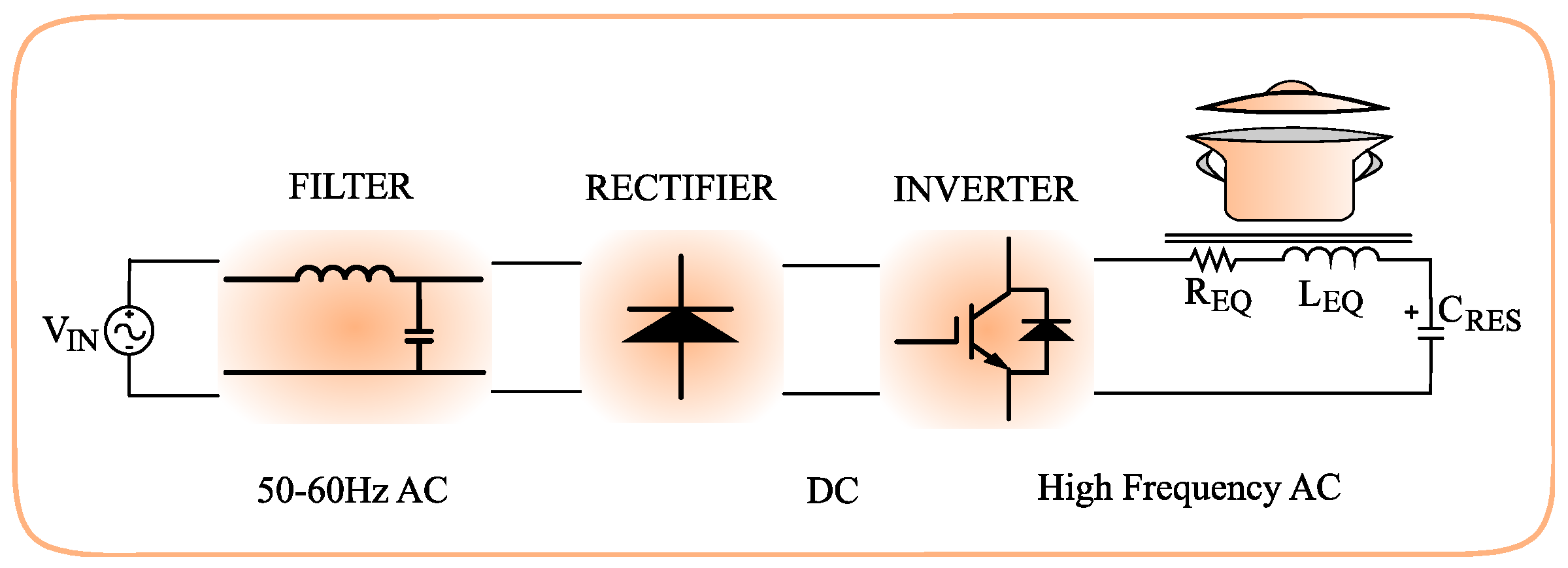
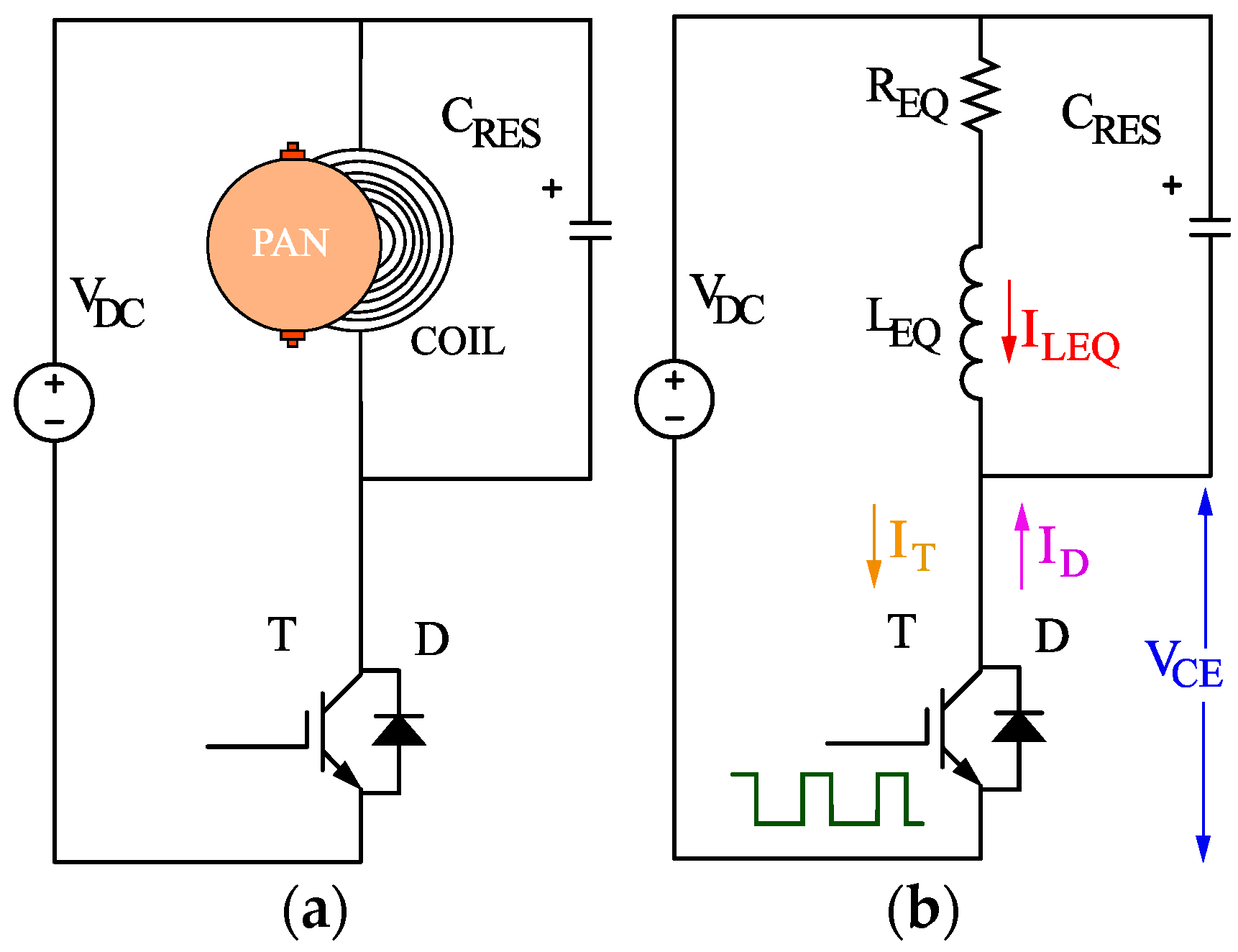
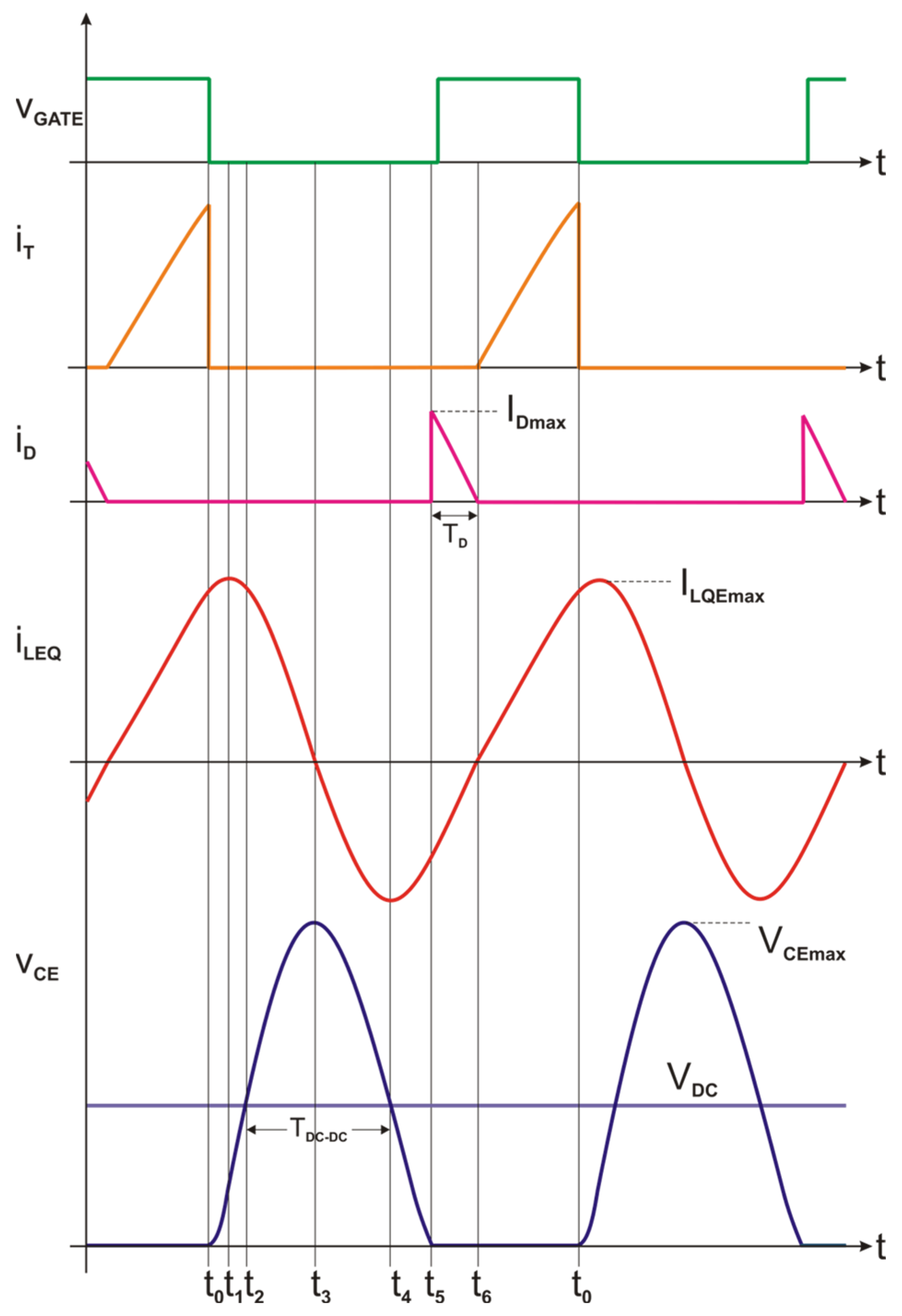
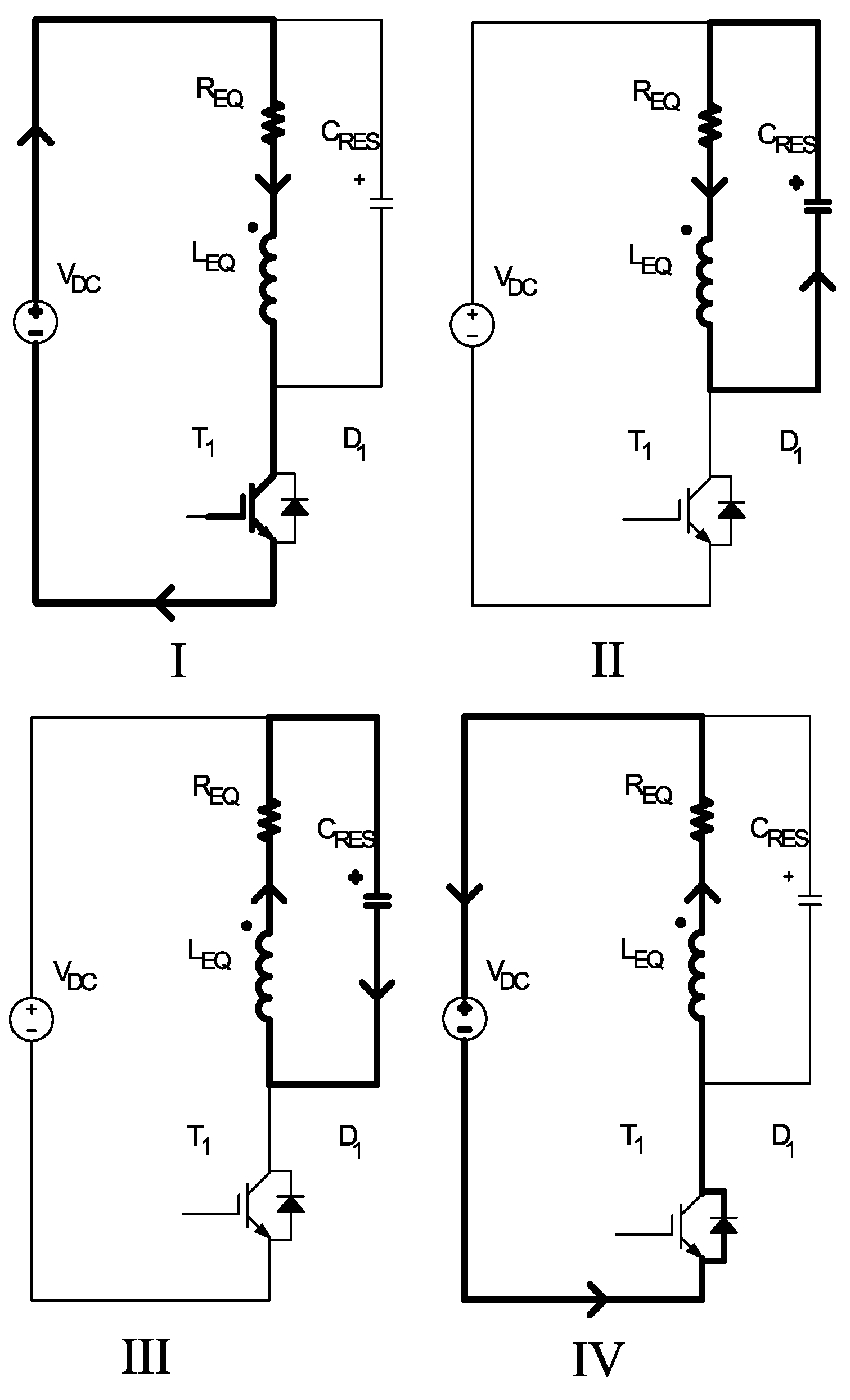

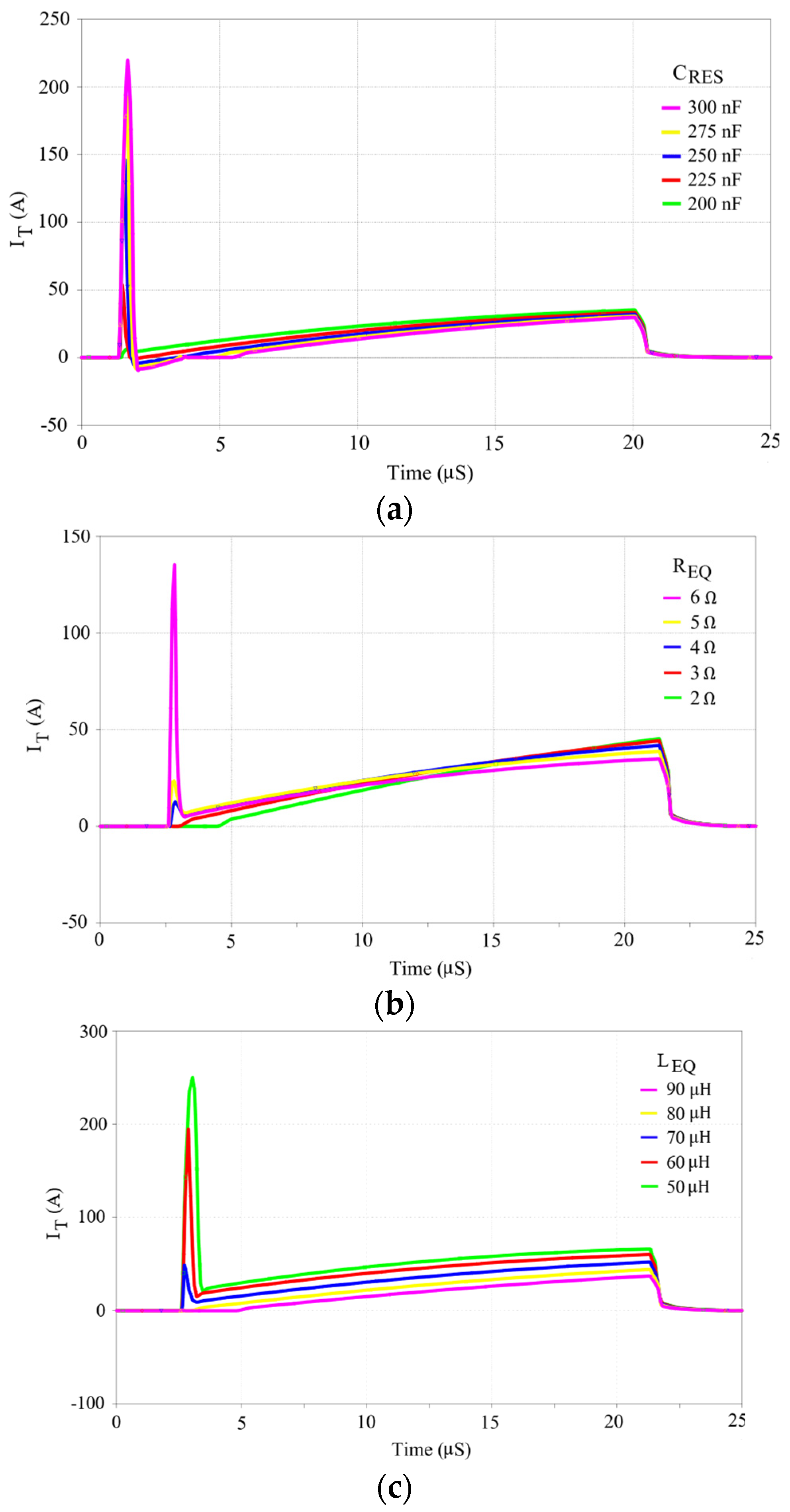


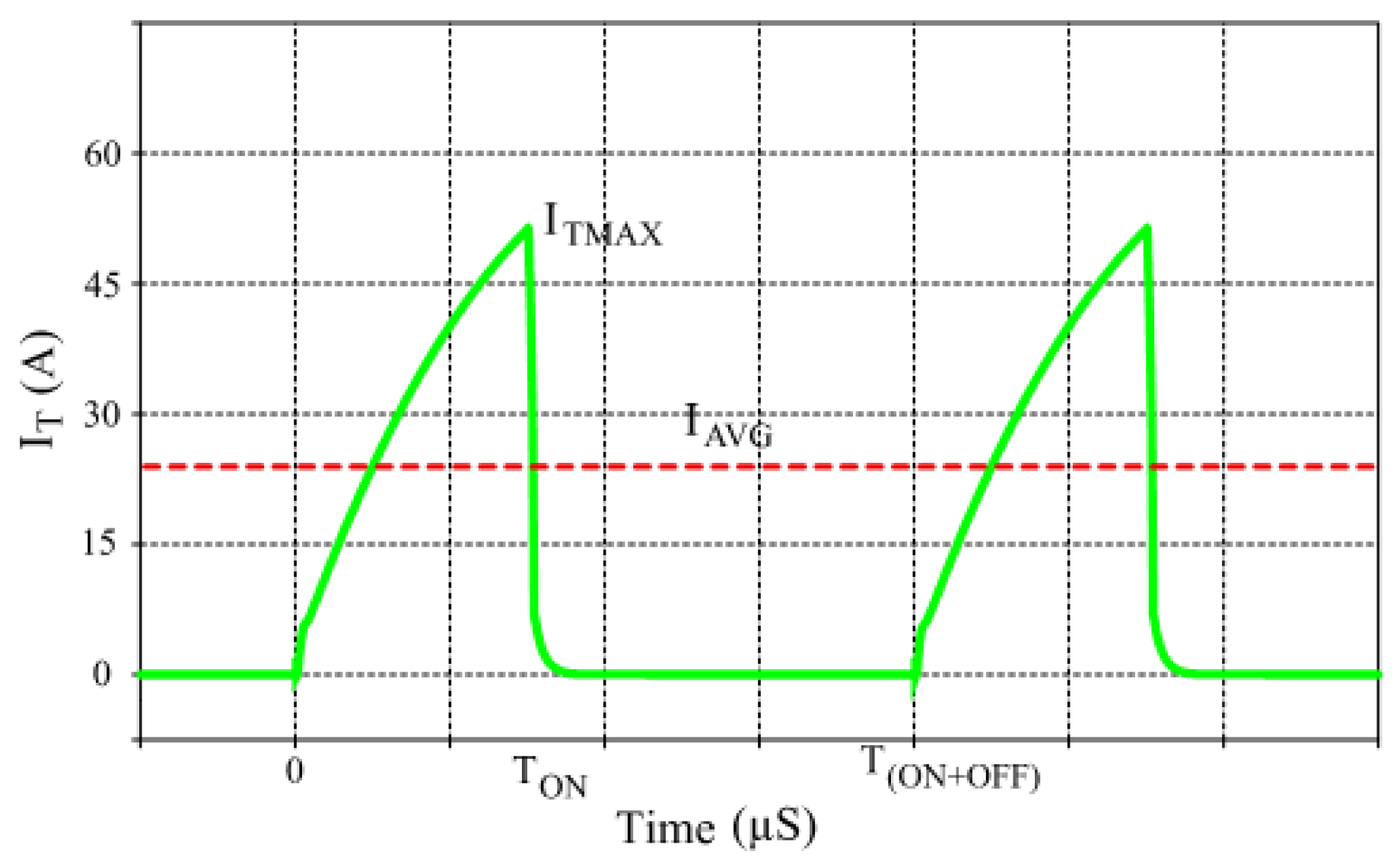

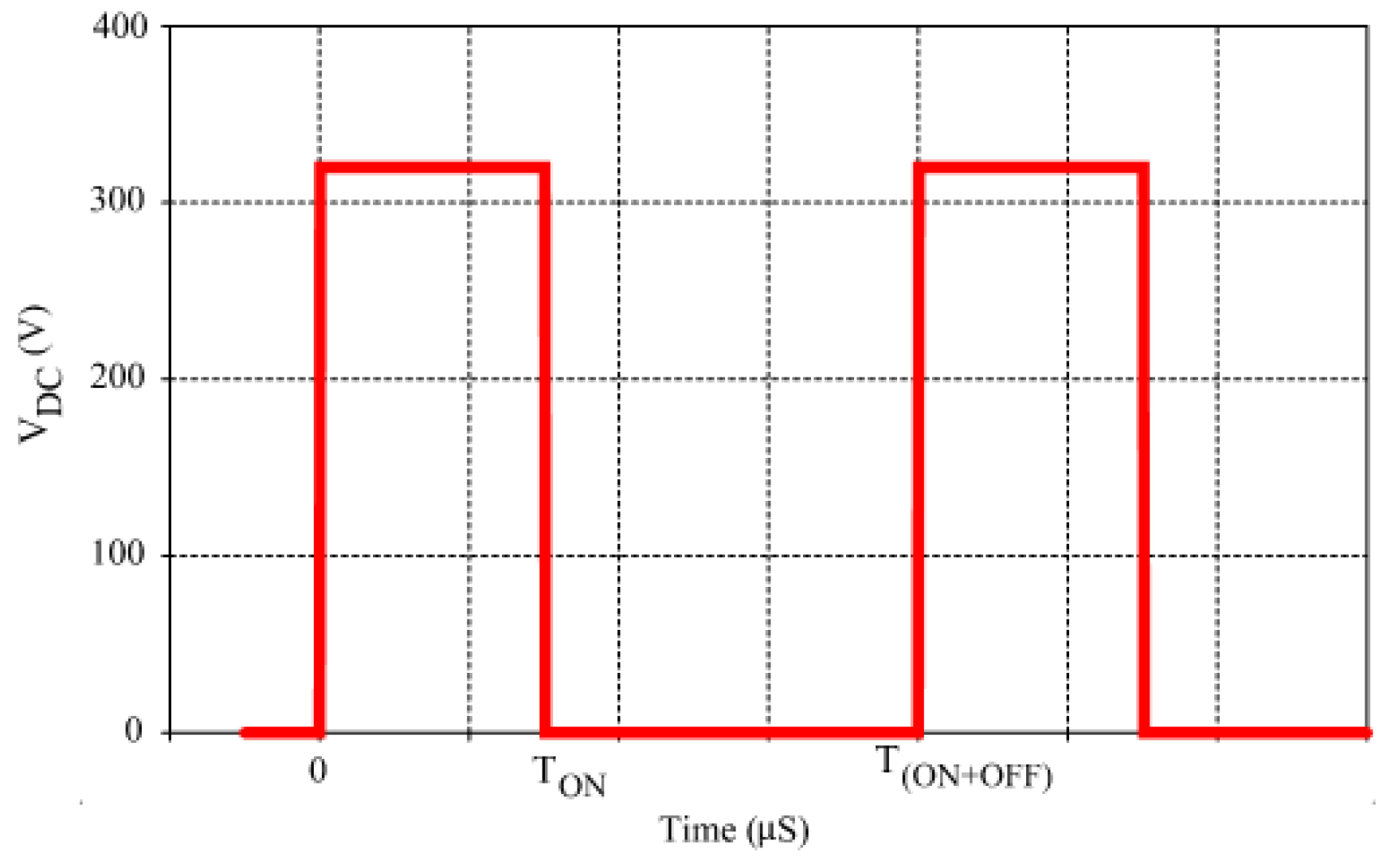

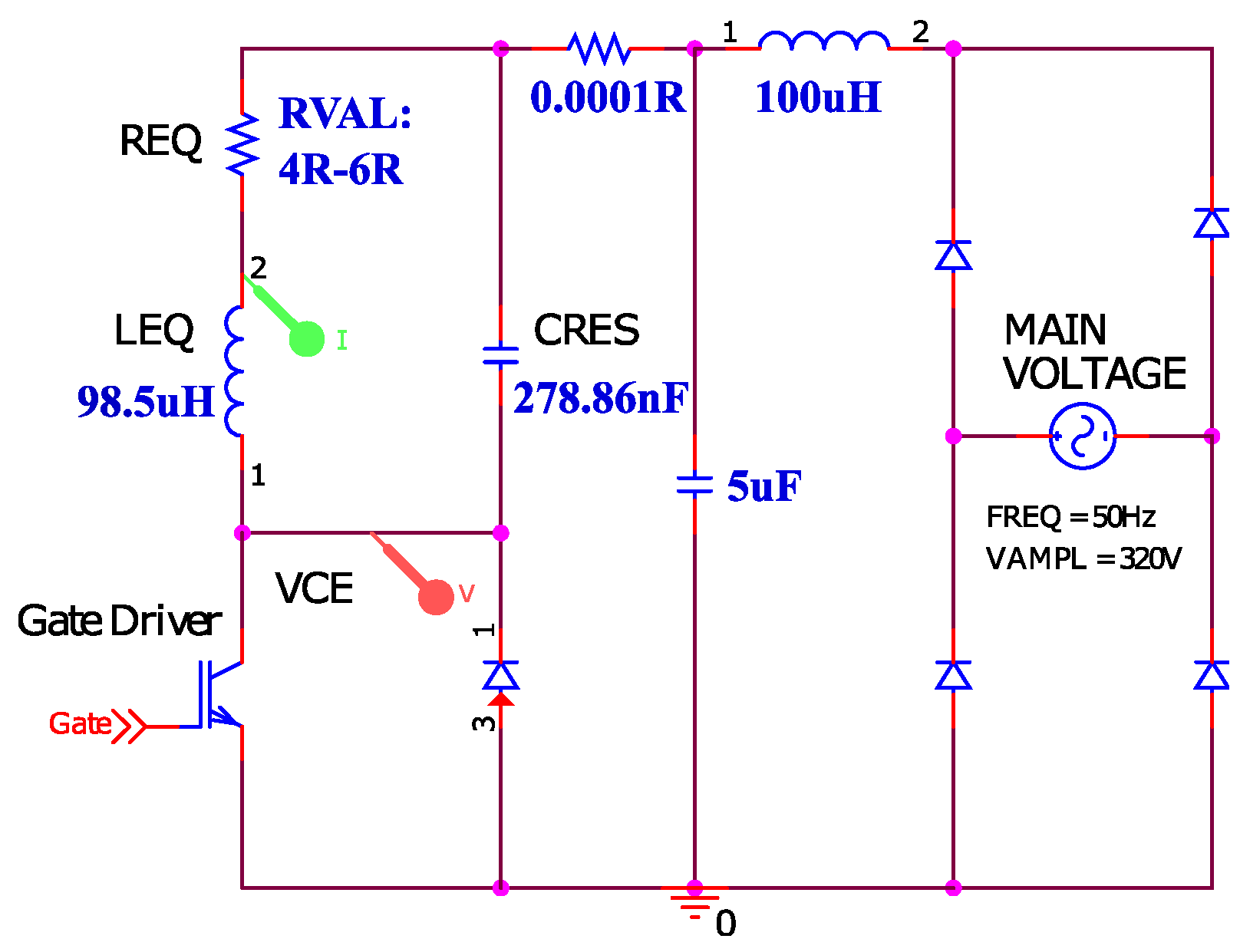

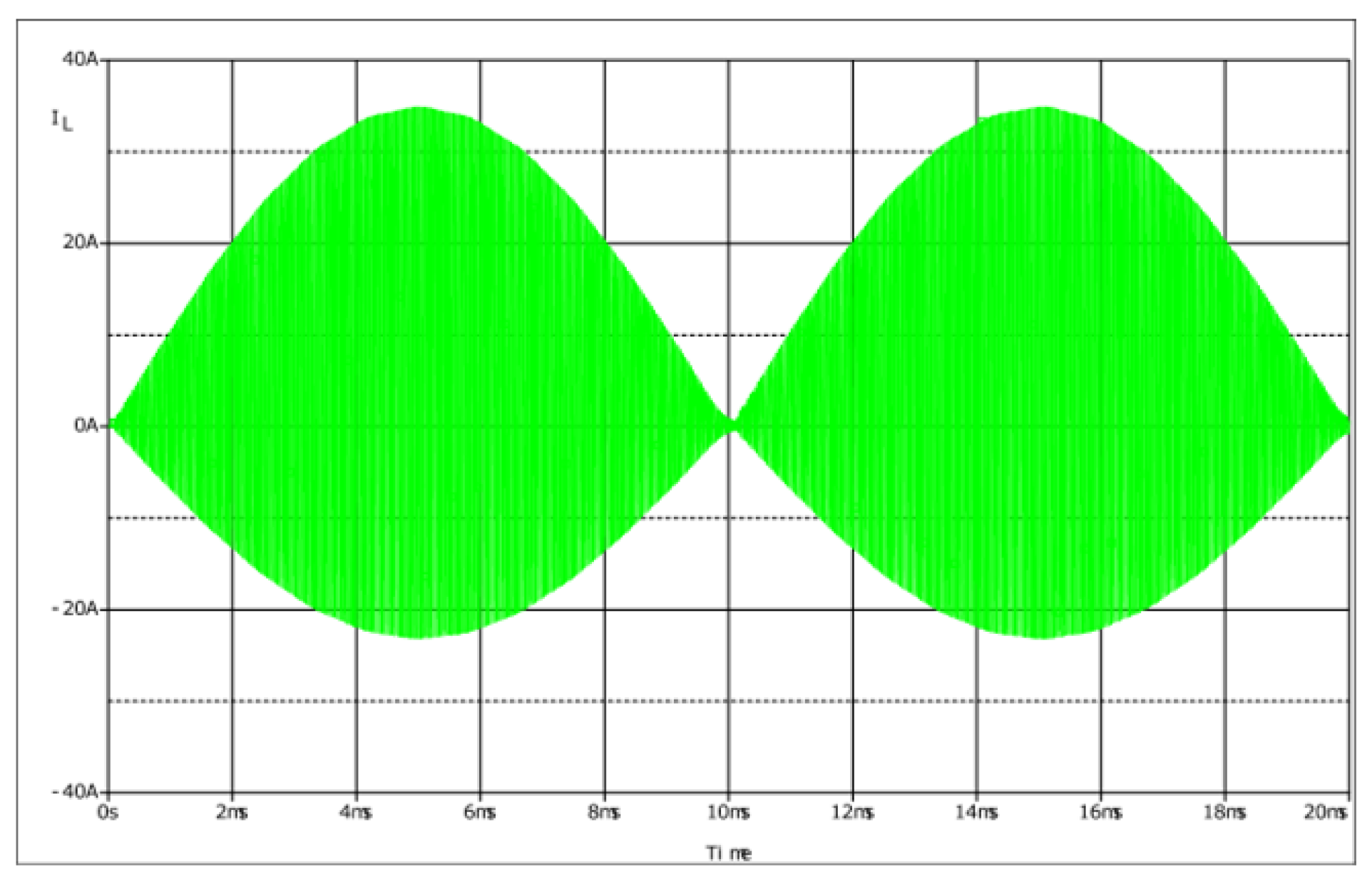

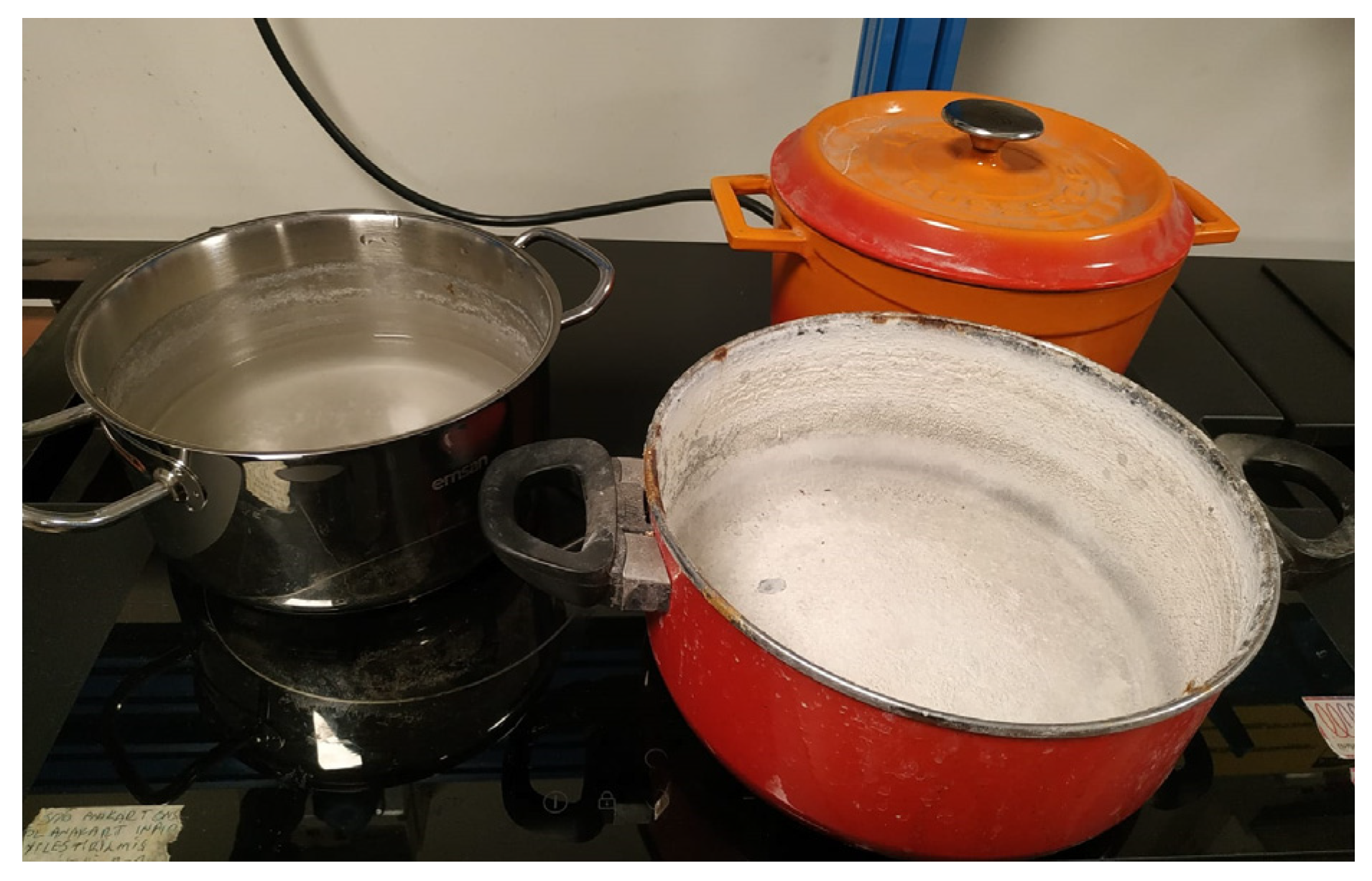
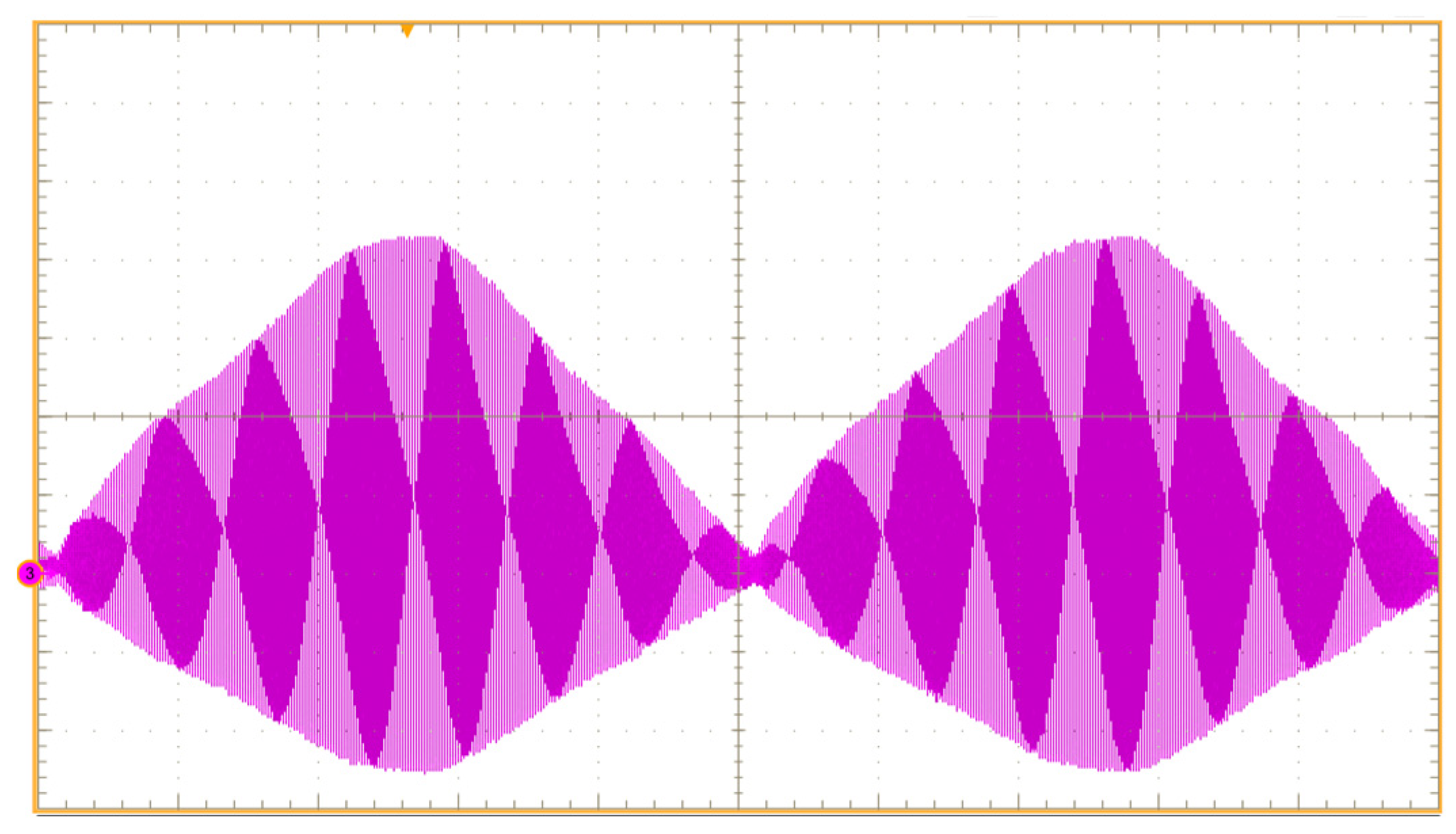



| Pre-Defined Circuit Parameters | |
|---|---|
| Calculated Circuit Parameters | |
| Calculated Boundary Conditions | |
| Input Circuit Parameters | Output Boundary Parameters | Output Power | |||
|---|---|---|---|---|---|
| Parameter | Symbol | Value | Unit |
|---|---|---|---|
| Number of turns | 28 | ||
| External diameter of the coil | 180 | mm | |
| Inner diameter of the coil | 30 | mm | |
| Distance between coil winding and ferrite bars | 4 | mm | |
| Distance between coil winding and pan | 4 | mm | |
| Strand amount of a litz wire | 66 | ||
| Wire diameter of single strand | 0.27 | ||
| Ferrite permeability | 800 | ||
| Equivalent inductance with no load | 110 | µH | |
| Equivalent resistance with no load | 0.12 | ||
| Equivalent inductance with cast iron pan | 89.76 | µH | |
| Equivalent resistance with cast iron pan | 4.21 | ||
| Equivalent inductance with stainless steel pan | 81.81 | µH | |
| Equivalent resistance with stainless steel pan | 3.36 | ||
| Equivalent inductance with silit silargan pan | 69.07 | µH | |
| Equivalent resistance with silit silargan pan | 2.48 |
| Input Circuit Parameters | Output Boundary Parameters | Output Power | |||
|---|---|---|---|---|---|
| Input Circuit Parameters | Output Boundary Parameters | Output Power | |||
|---|---|---|---|---|---|
Disclaimer/Publisher’s Note: The statements, opinions and data contained in all publications are solely those of the individual author(s) and contributor(s) and not of MDPI and/or the editor(s). MDPI and/or the editor(s) disclaim responsibility for any injury to people or property resulting from any ideas, methods, instructions or products referred to in the content. |
© 2023 by the author. Licensee MDPI, Basel, Switzerland. This article is an open access article distributed under the terms and conditions of the Creative Commons Attribution (CC BY) license (https://creativecommons.org/licenses/by/4.0/).
Share and Cite
Ozturk, M. A Simplified Design Method for Quasi-Resonant Inverter Used in Induction Hob. Electronics 2023, 12, 4145. https://doi.org/10.3390/electronics12194145
Ozturk M. A Simplified Design Method for Quasi-Resonant Inverter Used in Induction Hob. Electronics. 2023; 12(19):4145. https://doi.org/10.3390/electronics12194145
Chicago/Turabian StyleOzturk, Metin. 2023. "A Simplified Design Method for Quasi-Resonant Inverter Used in Induction Hob" Electronics 12, no. 19: 4145. https://doi.org/10.3390/electronics12194145






